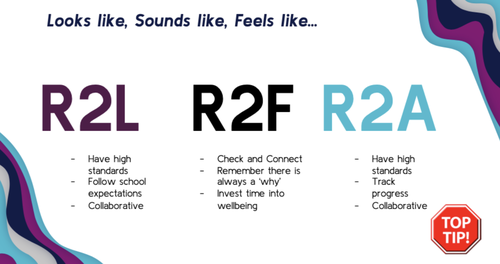For Rolleston College, a High School in Canterbury, wellbeing looks like their young adults having a packed kete full of hauora tools and strategies to help them flourish during their time at school and after.
We spoke to Sophie Ralph, Associate Principal and Kelly Tippett, Deputy Principal, to learn about how they are helping to fill their learner's hauora kete to the brim.
“School is open from 9.00am - 3.00pm, 40 weeks of the year but what happens after school? Or in summer? It’s important we teach our tamariki to put their own oxygen mask on first and equip them with the tools to manage their own wellbeing and mindset where possible, a concept we learnt from Dr Lucy Hone.”
“This looks like exposing our learners to as many tools as possible – Character Strengths, Growth Mindset, 5 Ways to Wellbeing, Te Whare Tapa Whā, Mindfulness, Learning Pit and Check and Connect. This means they can identify what’s right for them and draw on what they want to.”
Growing wellbeing
Among the foundation staff at Rolleston College grew a team of wellbeing champions who undertook research into different hauora models and decided that like education there is no 'one size fits all', deciding that a multi-pronged whole school approach was the right thing to do for their kura.
“We all thought about our own wellbeing needs differently. We all fill our cup in different ways - Kelly likes being in the outdoors and Sophie likes performing arts activities, so even as a team we understood the need for a flexible kete of tools.”
“When you've got that many kids through the door, and families, everyone's going to want and relate to something different.”
Although Rolleston College doesn’t follow just one wellbeing model, they do have an overarching belief for their school.
“We have a core ethos of ‘Ready to Learn, Ready to Achieve and Ready to Flourish’ and believe that all three of these components must work together for our learners to be feeling good and functioning well."

Kelly and Sophie like to think of these three components as very similar to the pou of Te Whare Tapa Whā - if one of these pillars is not being looked after, the learners are likely not feeling good and functioning well.
This model works because Rolleston College works hard to get to know its learners right from the word go.
“During the year, we print off names of our year nine cohort and put the pictures up in our staffroom. We asked staff over a week to put a tick on their students that they know something about beyond the classroom. To show that they formed a relationship and get them to ask themselves do they know these kids.”
“At the end of the week we look and if there were kids who had no ticks, we know it was important to connect with them and we might have to go out of our way. We also looked at kids who had heaps of ticks, questioning how we’ve gotten to know them so well. What’s worked?”
“This is really important to us. To connect, we need to know the whole rangatahi, not just the person they are in the classroom and for them to know us too. This is where Check and Connect comes into play for us.”
Continuing connection with ākonga
Check and Connect is a model that sees time set aside in the classroom for the teachers and learners to check in with one another – it can be as simple as a thumbs up or down or they might use different tools like the ‘blob tree’. The blob feelings tree is used to articulate their feelings and help facilitate their development.
Check and Connect is adopted school-wide and is now something that students look forward to as an outlet where sharing your true emotions are okay.
For Rolleston College, it was a non-negotiable to integrate wellbeing into everything that they do for both staff and learners.
“It has to be culture and curriculum for us at our school and we need to connect with all stakeholders who are in our school and our community. So, it's not a session once a week, it is what we do.”
Kelly and Sophie have some advice for schools that are interested in starting their whole school approach.
“Learn, live, teach and embed. Making wellbeing a part of everything that you do rather than just tacking it on for an hour a week.”
“Make sure you have a baseline of exactly what you want to cover, that might look like starting small and working your way up. It’s important to have wellbeing champions too, lots of them. It can’t just come from the top or one person, it’s about making wellbeing your culture and always looking at the why.”
Kelly leaves us with the famous Tom Herner quote:
“If a child can't read, we teach them. If they can't write, we teach them. If they can't swim, we teach them. If they can't behave, we guide them. But, there’s always a ‘why’ behind behaviour and things that they do, and the way that they treat other people.
“If you unpack that, then that is most likely always going to be related to their well-being and what's going on for them so that’s where it’s important to connect with your learners and their whānau leaning on those strong relationships.”
